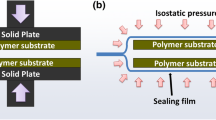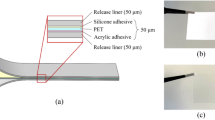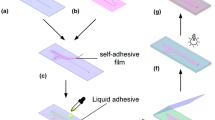Abstract
Thermoplastics are highly attractive substrate materials for microfluidic systems, with important benefits in the development of low cost disposable devices for a host of bioanalytical applications. While significant research activity has been directed towards the formation of microfluidic components in a wide range of thermoplastics, sealing of these components is required for the formation of enclosed microchannels and other microfluidic elements, and thus bonding remains a critical step in any thermoplastic microfabrication process. Unlike silicon and glass, the diverse material properties of thermoplastics opens the door to an extensive array of substrate bonding options, together with a set of unique challenges which must be addressed to achieve optimal sealing results. In this paper we review the range of techniques developed for sealing thermoplastic microfluidics and discuss a number of practical issues surrounding these various bonding methods.









Similar content being viewed by others
References
Abgrall P, Lattes C, Conederal V, Dollat X, Colin S, Gue AM (2006) A novel fabrication method of flexible and monolithic 3D microfluidic structures using lamination of SU-8 films. J Micromech Microeng 16(1):113–121
Abgrall P, Low LN, Nguyen NT (2007) Fabrication of planar nanofluidic channels in a thermoplastic by hot-embossing and thermal bonding. Lab Chip 7(4):520–522
Ahn CH, Choi JW, Beaucage G, Nevin JH, Lee JB, Puntambekar A, Lee JY (2004) Disposable Smart lab on a chip for point-of-care clinical diagnostics. Proc IEEE 92(1):154–173
Allen NS, Edge M (1992) Fundamentals of polymer degradation and stabilization. Elsevier, New York
Arroyo MT, Fernandez LJ, Agirregabiria M, Ibanez N, Aurrekoetxea J, Blanco FJ (2007) Novel all-polymer microfluidic devices monolithically integrated within metallic electrodes for SDS-CGE of proteins. J Micromech Microeng 17(7):1289–1298
Barton AFM (1991) Handbook of solubility parameters end other cohesion parameters. CRC Press, Boca Raton
Becker H, Gartner C (2000) Polymer microfabrication methods for microfluidic analytical applications. Electrophoresis 21(1):12–26
Becker H, Gartner C (2008) Polymer microfabrication technologies for microfluidic systems. Anal Bioanal Chem 390(1):89–111
Becker H, Locascio LE (2002) Polymer microfluidic devices. Talanta 56(2):267–287
Bhattacharyya A, Klapperich CM (2006) Thermoplastic microfluidic device for on-chip purification of nucleic acids for disposable diagnostics. Anal Chem 78(3):788–792
Bhattacharyya A, Klapperich CM (2007) Mechanical and chemical analysis of plasma and ultraviolet-ozone surface treatments for thermal bonding of polymeric microfluidic devices. Lab Chip 7(7):876–882
Bolon DA, Kunz CO (1972) Ultraviolet depolymerization of photoresist polymers. Polym Eng Sci 12(2):109
Brown L, Koerner T, Horton JH, Oleschuk RD (2006) Fabrication and characterization of poly(methylmethacrylate) microfluidic devices bonded using surface modifications and solvents. Lab Chip 6(1):66–73
Brydson J (1999) Plastic materials. Butterworth-Heinemann, Oxford
Buch JS, Kimball C, Rosenberger F, Highsmith WE Jr, DeVoe DL, Lee CS (2004) DNA mutation detection in a polymer microfluidic network using temperature gradient gel electrophoresis. Anal Chem 76:874–881
Chen ZF, Gao YH, Su RG, Li CW, Lin JM (2003) Fabrication and characterization of poly(methyl methacrylate) microchannels by in situ polymerization with a novel metal template. Electrophoresis 24(18):3246–3252
Chen Y, Zhang LY, Chen G (2008a) Fabrication, modification, and application of department of analytical poly(methyl methacrylate) microfluidic chips. Electrophoresis 29(9):1801–1814
Chen G, Svec F, Knapp DR (2008b) Light-actuated high pressure-resisting microvalve for on-chip flow control based on thermo-responsive nanostructured polymer. Lab Chip 8(7):1198–1204
Chow WWY, Lei KF, Shi GY, Li WJ, Huang Q (2006) Microfluidic channel fabrication by PDMS-interface bonding. Smart Mater Struct 15(1):S112–S116
Collaud M, Groening P, Nowak S, Schlapbach L (1994) Plasma Treatment of Polymers - the Effect of the Plasma Parameters on the Chemical, Physical, and Morphological States of the Polymer Surface and on the Metal-Polymer Interface. J Adh Sci Technol 8(10):1115–1127
Dang F, Shinohara S, Tabata O, Yamaoka Y, Kurokawa M, Shinohara Y, Ishikawa M, Baba Y (2005) Replica multichannel polymer chips with a network of sacrificial channels sealed by adhesive printing method. Lab Chip 5(4):472–478
Eddings MA, Johnson MA, Gale BK (2008) Determining the optimal PDMS-PDMS bonding technique for microfluidic devices. J Micromech Microeng 18(6)
Emanuel NM, Buchachenko AL (1987) Chemical Physics of Polymer Degradation and Stabilization. VNU Science Press, Utrecht
Fitzpatrick LJ, Dean JR (2002) Extraction solvent selection in environmental analysis. Anal Chem 74(1):74–79
Fredrickson CK, Xia Z, Das C, Ferguson R, Tavares FT, Fan ZH (2006) Effects of fabrication process parameters on the properties of cyclic olefin copolymer microfluidic devices. J Microelectromech Syst 15(5):1060–1068
Giselbrecht S, Gietzelt T, Gottwald E, Trautmann C, Truckenmuller R, Weibezahn KF, Welle A (2006) 3D tissue culture substrates produced by microthermoforming of pre-processed polymer films. Biomed Microdevices 8(3):191–199
Griebel A, Rund S, Schonfeld F, Dorner W, Konrad R, Hardt S (2004) Integrated polymer chip for two-dimensional capillary gel electrophoresis. Lab Chip 4(1):18–23
Han J, Lee SH, Puntambekar A, Murugesan S, Choi J-W, Beaucage G, Ahn CH (2003) UV adhesive bonding techniques at room temperature for plastic lab-on-a-chip. In: Proceedings of 7th International Conference Micro Total Analysis Systems. Squaw Valley, CA, pp 1113–1116
Hansen CM (1969) The universality of the solubility parameter. Ind Eng Chem Prod Res Dev 8:2–11
Hildebrandt J, Scott R (1949) The solubility of non-electrolytes. Reinhold, New York
Hromada LP, Nablo BJ, Kasianowicz JJ, Gaitan MA, DeVoe DL (2008) Single molecule measurements within individual membrane-bound ion channels using a polymer-based bilayer lipid membrane chip. Lab Chip 8(4):602–608
Hsu YC, Chen TY (2007) Applying Taguchi methods for solvent-assisted PMMA bonding technique for static and dynamic mu-TAS devices. Biomed Microdevices 9(4):513–522
Hu SW, Brittain WJ (2005) Surface grafting on polymer surface using physisorbed free radical initiators. Macromolecules 38(15):6592–6597
Huang F-C, Chen Y-F, Lee G-B (2007) CE chips fabricated by injection molding and polyethylene/thermoplastic elastomer film packaging methods. Electrophoresis 28(7):1130–1137
Johansson BL, Larsson A, Ocklind A, Ohrlund A (2002) Characterization of air plasma-treated polymer surfaces by ESCA and contact angle measurements for optimization of surface stability and cell growth. J Appl Polym Sci 86(10):2618–2625
Kelly RT, Woolley AT (2003) Thermal bonding of polymeric capillary electrophoresis microdevices in water. Anal Chem 75(8):1941–1945
Kelly RT, Pan T, Woolley AT (2005) Phase-changing sacrificial materials for solvent bonding of high-performance polymeric capillary electrophoresis microchips. Anal Chem 77(11):3536–3541
Kettner P, Pelzer RL, Glinsner T, Farrens S (2006) New results on plasma activated bonding of imprinted features for Bio MEMS applications. J Phys Conf Ser 34:65–71
Kim J, Xu XF (2003) Excimer laser fabrication of polymer microfluidic devices. J Laser Appl 15(4):255–260
Klank H, Kutter JP, Geschke O (2002) CO2-laser micromachining and back-end processing for rapid production of PMMA-based microfluidic systems. Lab Chip 2(4):242–246
Klintberg L, Svedberg M, Nikolajeff F, Thornell G (2003) Fabrication of a paraffin actuator using hot embossing of polycarbonate. Sens Actuators A Physs 103(3):307–316
Koesdjojo MT, Tennico YH, Reincho VT (2008) Fabrication of a microfluidic system for capillary electrophoresis using a two-stage embossing technique and solvent welding on poly(methyl methacrylate) with water as a sacrificial layer. Anal Chem 80(7):2311–2318
Kruse A, Kruger G, Baalmann A, Hennemann OD (1995) Surface pretreatment of plastics for adhesive bonding. J Adh Sci Technol 9(12):1611–1621
do Lago CL, da Silva HDT, Neves CA, Brito-Neto JGA, da Silva JAF (2003) A dry process for production of microfluidic devices based on the lamination of laser-printed polyester films. Anal Chem 75(15):3853–3858
Lai S, Cao X, Lee LJ (2004) A packaging technique for polymer microfluidic platforms. Anal Chem 76(4):1175–1183
Lee GB, Lin CH, Lee KH, Lin YF (2005) On the surface modification of microchannels for microcapillary electrophoresis chips. Electrophoresis 26(24):4616–4624
Lei KF, Ahsan S, Budraa N, Li WJ, Mai JD (2004) Microwave bonding of polymer-based substrates for potential encapsulated micro/nanofluidic device fabrication. Sens Actuators A Phys 114(2–3):340–346
Li Y, Buch JS, Rosenberger F, DeVoe DL, Lee CS (2004) Integration of isoelectric focusing with parallel sodium dodecyl sulfate gel electrophoresis for multidimensional protein separations in a plastic microfludic network. Anal Chem 76:742–748
Li JH, Chen D, Chen G (2005) Low-temperature thermal bonding of PMMA microfluidic chips. Anal Lett 38(7):1127–1136
Lin C–H, Fu L-M, Tsai C–H, Chao C–H, Lan C–W (2005) Low azeotropic solvent sealing of PMMA microfluidic devices. In: The 13th international conference on solid-state sensors, actuators, and microsystems (transducers 05), Seoul, Korea, pp 944–947
Lin CH, Chao CH, Lan CW (2007) Low azeotropic solvent for bonding of PMMA microfluidic devices. Sensors and Actuators B-Chemical 121(2):698–705
Liu J, Ro KW, Nayak R, Knapp DR (2007) Monolithic column plastic microfluidic device for peptide analysis using electrospray from a channel opening on the edge of the device. Int J Mass Spectrom 259(1–3):65–72
Liu J, Yang S, Lee CS, DeVoe DL (2008) Polyacrylamide gel plugs enabling 2-D microfluidic protein separations via isoelectric focusing and multiplexed sodium dodecyl sulfate gel electrophoresis. Electrophoresis 29(11):2241–2250
Locascio LE, Perso CE, Lee CS (1999) Measurement of electroosmotic flow in plastic imprinted microfluid devices and the effect of protein adsorption on flow rate. J Chromatogr A 857(1–2):275–284
Lu C, Lee LJ, Juang Y-J (2008) Packaging of microfluidic chips via interstitial bonding technique. Electrophoresis 29(7):1407–1414
Mair DA, Rolandi M, Snauko M, Noroski R, Svec F, Frechet JMJ (2007) Room-temperature bonding for plastic high-pressure microfluidic chips. Anal Chem 79(13):5097–5102
Martynova L, Locascio LE, Gaitan M, Kramer GW, Christensen RG, MacCrehan WA (1997) Fabrication of plastic microfluid channels by imprinting methods. Anal Chem 69(23):4783–4789
McCormick RM, Nelson RJ, AlonsoAmigo MG, Benvegnu J, Hooper HH (1997) Microchannel electrophoretic separations of DNA in injection-molded plastic substrates. Anal Chem 69(14):2626–2630
Morales AM, Simmons BA, Wallow TI, Krafcik KL, Domier LA (2006) Low distortion, high strength bonding of polymer microfluidic chips exploiting case II permeation. In: 10th international conference on miniaturized systems for chemistry and life sciences. 1:155–157
Ng SH, Tjeung RT, Wang ZF, Lu ACW, Rodriguez I, de Rooij NF (2008) Thermally activated solvent bonding of polymers. Microsyst Tech Micro Nanosyst Inf Storage Process Syst 14(6):753–759
Nie Z, Fung YS (2008) Microchip capillary electrophoresis for frontal analysis of free bilirubin and study of its interaction with human serum albumin. Electrophoresis 29(9):1924–1931
Nikcevic I, Lee SH, Piruska A, Ahn CH, Ridgway TH, Limbach PA, Wehmeyer KR, Heineman WR, Seliskar CJ (2007) Characterization and performance of injection molded poly(methylmethacrylate) microchips for capillary electrophoresis. J Chromatogr A 1154(1–2):444–453
Nikolova D, Dayss E, Leps G, Wutzler A (2004) Surface modification of cycloolefinic copolymers for optimization of the adhesion to metals. Surf Interface Anal 36(8):689–693
Olivero D, Fan ZH (2008) Chips & tips: lamination of plastic microfluidic devices. Lab Chip. http://www.rsc.org/Publishing/Journals/lc/Chips_and_Tips/lamination.asp
Park DSW, Hupert ML, Witek MA, You BH, Datta P, Guy J, Lee JB, Soper SA, Nikitopoulos DE, Murphy MC (2008) A titer plate-based polymer microfluidic platform for high throughput nucleic acid purification. Biomed Microdevices 10(1):21–33
Paul D, Pallandre A, Miserere S, Weber J, Viovy J-L (2007) Lamination-based rapid prototyping of microfluidic devices using flexible thermoplastic substrates. Electrophoresis 28(7):1115–1122
Peeling J, Clark DT (1983) Surface ozonation and photo-oxidation of polyethylene film. J Polym Sci A Polym Chem 21(7):2047–2055
Pepin A, Youinou P, Studer V, Lebib A, Chen Y (2002) Nanoimprint lithography for the fabrication of DNA electrophoresis chips. Microelectron Eng 61–2:927–932
Piruska A, Nikcevic I, Lee SH, Ahn C, Heineman WR, Limbach PA, Seliskar CJ (2005) The autofluorescence of plastic materials and chips measured under laser irradiation. Lab Chip 5(12):1348–1354
Pocius AV (2002) Adhesion and adhesives technology: an introduction. Hanser/Gardner Publications, Cincinnati
Puntambekar A, Murugesan S, Trichur R, Cho HJ, Kim S, Choi J, Beaucage G, Ahn CH (2002) Effect of surface modification on thermoplastic fusion bonding for 3-D microfluidics. In: Proceedings of the 6th International Conference on Micro Total Analysis Systems Nara, Japan, pp 425–427
Raghavan D, VanLandingham M, Gu X, Nguyen T (2000) Characterization of heterogeneous regions in polymer systems using tapping mode and force mode atomic force microscopy. Langmuir 16(24):9448–9459
Reyes DR, Iossifidis D, Auroux PA, Manz A (2002) Micro total analysis systems. 1. Introduction, theory, and technology. Anal Chem 74(12):2623–2636
Riegger L, Grumann M, Steigert J, Lutz S, Steinert CP, Mueller C, Viertel J, Prucker O, Ruhe J, Zengerle R, Ducree J (2007) Single-step centrifugal hematocrit determination on a 10-$ processing device. Biomed Microdevices 9(6):795–799
Ro KW, Liu H, Knapp DR (2006) Plastic microchip liquid chromatography-matrix-assisted laser desorption/ionization mass spectrometry using monolithic columns. J Chromatogr A 1111(1):40–47
Roberts MA, Rossier JS, Bercier P, Girault H (1997) UV laser machined polymer substrates for the development of microdiagnostic systems. Anal Chem 69(11):2035–2042
Rossier J, Reymond F, Michel PE (2002) Polymer microfluidic chips for electrochemical and biochemical analyses. Electrophoresis 23(6):858–867
Rotting O, Ropke W, Becker H, Gartner C (2002) Polymer microfabrication technologies. Microsystem Technologies 8(1):32–36
Schultz J, Nardin M (1994) Theories and mechanisms of adhesion. In: Mittal APAKL (ed) Handbook of adhesive technology. Marcel Dekker, New York, pp 19–33
Shadpour H, Musyimi H, Chen JF, Soper SA (2006) Physiochemical properties of various polymer substrates and their effects on microchip electrophoresis performance. J Chromatogr A 1111(2):238–251
Shadpour H, Hupert ML, Patterson D, Liu CG, Galloway M, Stryjewski W, Goettert J, Soper SA (2007) Multichannel microchip electrophoresis device fabricated in polycarbonate with an integrated contact conductivity sensor array. Anal Chem 79(3):870–878
Shah JJ, Geist J, Locascio LE, Gaitan M, Rao MV, Vreeland WN (2006) Capillarity induced solvent-actuated bonding of polymeric microfluidic devices. Anal Chem 78(10):3348–3353
Shenton MJ, Lovell-Hoare MC, Stevens GC (2001) Adhesion enhancement of polymer surfaces by atmospheric plasma treatment. J Phys D Appl Phys 34(18):2754–2760
Sowell RR, Cuthrell RE, Mattox DM, Bland RD (1974) Surface Cleaning by Ultraviolet-Radiation. J Vac Sci Technol A 11(1):474–475
Steigert J, Haeberle S, Brenner T, Muller C, Steinert CP, Koltay P, Gottschlich N, Reinecke H, Ruhe J, Zengerle R, Ducree J (2007) Rapid prototyping of microfluidic chips in COC. J Micromech Microeng 17(2):333–341
Strong AB (2000) Plastics Materials and Processing. Prentice-Hall, Upper Saddle River
Sun Y, Kwok YC, Nguyen NT (2006) Low-pressure, high-temperature thermal bonding of polymeric microfluidic devices and their applications for electrophoretic separation. J Micromech Microeng 16(8):1681–1688
Sun XH, Peeni BA, Yang W, Becerril HA, Woolley AT (2007) Rapid prototyping of poly(methyl methacrylate) microfluidic systems using solvent imprinting and bonding. J Chromatogr A 1162(2):162–166
Taberham A, Kraft M, Mowlem M, Morgan H (2008) The fabrication of lab-on-chip devices from fluoropolymers. J Micromech Microeng 18(6):064011
Tan HY, Loke WK, Tan YT, Nguyen N-T (2008) A lab-on-a-chip for detection of nerve agent sarin in blood. Lab Chip 8(6):885–891
Truckenmuller R, Henzi P, Herrmann D, Saile V, Schomburg WK (2004) A new bonding process for polymer micro- and nanostructures based on near-surface degradation. In: 17th IEEE International Conference on Micro Electro Mechanical Systems, pp 761–764
Truckenmuller R, Henzi P, Herrmann D, Saile V, Schomburg WK (2004b) Bonding of polymer microstructures by UV irradiation and subsequent welding at low temperatures. Microsyst Technol 10(5):372–374
Truckenmuller R, Ahrens R, Cheng Y, Fischer G, Saile V (2006a) An ultrasonic welding based process for building up a new class of inert fluidic microsensors and -actuators from polymers. Sens Actuators A Phys 132(1):385–392
Truckenmuller R, Cheng Y, Ahrens R, Bahrs H, Fischer G, Lehmann J (2006b) Micro ultrasonic welding: joining of chemically inert polymer microparts for single material fluidic components and systems. Microsyst Tech Micro Nanosyst Inf Storage Process Syst 12(10–11):1027–1029
Tsao CW, Hromada L, Liu J, Kumar P, DeVoe DL (2007) Low temperature bonding of PMMA and COC microfluidic substrates using UV/ozone surface treatment. Lab Chip 7(4):499–505
Tsao C-W, Liu J, DeVoe DL (2008) Droplet formation from hydrodynamically coupled capillaries for parallel microfluidic contact spotting. J Micromech Microeng 18:025013
Uyama Y, Kato K, Ikada Y (1998) Surface modification of polymers by grafting. Graf Charact Tech Kinet Model 137:1–39
Velten T, Schuck H, Richter M, Klink G, Bock K, Khan Malek C, Roth S, Schoo H, Bolt PJ (2008) Microfluidics on foil: state of the art and new developments. Proc IMechE Part B J Eng Manuf 222(1):107–116
Vig JR (1985) Uv ozone cleaning of surfaces. J Vac Sci Technol A Vac Surf Films 3(3):1027–1034
Vig JR, LeBus JW (1976) UV/ozone cleaning of surfaces. IEEE Trans Parts Hybrid Packag PHP 12:365–370
Wallow TI, Morales AM, Simmons BA, Hunter MC, Krafcik KL, Domeier LA, Sickafoose SM, Patel KD, Gardea A (2007) Low-distortion, high-strength bonding of thermoplastic microfluidic devices employing case-II diffusion-mediated permeant activation. Lab Chip 7(12):1825–1831
Wang Y-X, Zhou Y, Balgley BM, Cooper JW, Lee CS, DeVoe DL (2005) Electrospray interfacing of polymer microfluidics to MALDI-MS. Electrophoresis 26:3631–3640
Wang YR, Chen HW, He QH, Soper SA (2008) A high-performance polycarbonate electrophoresis microchip with integrated three-electrode system for end-channel amperometric detection. Electrophoresis 29(9):1881–1888
Witek MA, Wei S, Vaidya B, Adams AA, Zhu L, Stryjewski W, McCarley RL, Soper SA (2004) Cell transport via electromigration in polymer-based microfluidic devices. Lab Chip 4:464–472
Wu S (1982) Polymer Interface and Adhesion. Marcel Dekker, New York
Wu ZY, Xanthopoulos N, Reymond F, Rossier JS, Girault HH (2002) Polymer microchips bonded by O-2-plasma activation. Electrophoresis 23(5):782–790
Xia Y, Whitesides GM (1998) Soft lithography. Angew Chem Int Ed Engl 37:550–575
Xu JD, Locascio L, Gaitan M, Lee CS (2000) Room-temperature imprinting method for plastic microchannel fabrication. Anal Chem 72(8):1930–1933
Yao LY, Liu B, Chen T, Liu SB, Zuo TC (2005) Micro flow-through PCR in a PMMA chip fabricated by KrF excimer laser. Biomed Microdevices 7(3):253–257
Yussuf AA, Sbarski I, Solomon M, Tran N, Hayes JP (2007) Sealing of polymeric-microfluidic devices by using high frequency electromagnetic field and screen printing technique. J Mater Process Technol 189(1–3):401–408
Zhu XL, Liu G, Guo YH, Tian YC (2007) Study of PMMA thermal bonding. Microsyst Tech Micro Nanosyst Inf Storage Process Syst 13(3–4):403–407
Author information
Authors and Affiliations
Corresponding author
Rights and permissions
About this article
Cite this article
Tsao, CW., DeVoe, D.L. Bonding of thermoplastic polymer microfluidics. Microfluid Nanofluid 6, 1–16 (2009). https://doi.org/10.1007/s10404-008-0361-x
Received:
Accepted:
Published:
Issue Date:
DOI: https://doi.org/10.1007/s10404-008-0361-x




